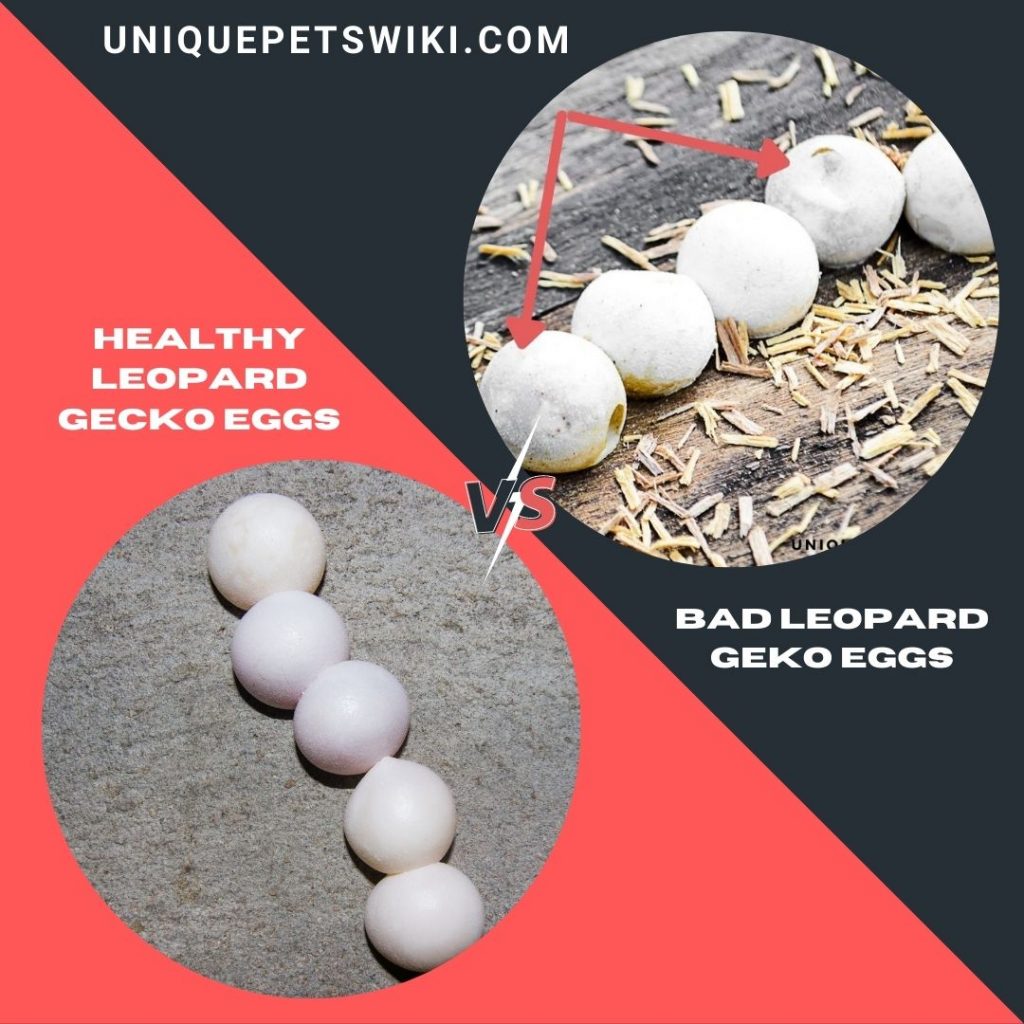It is never enough to know what is the best food or house for your leopard gecko while you have no idea about its reproduction behavior. Breeding represents life! Sometimes back, a friend of my friend asked me a very important question.
He has an incubator for incubating his chicken eggs and wanted to know if he could also incubate the eggs from his gecko. Another person somewhere also asked me if she touches her gecko’s eggs with bare hands, they will hatch.
So, I felt the need to write and share the best care for leopard gecko eggs and inform many people. Therefore, this article will guide you on caring for the gecko eggs and the newly hatched Leos.
Contents
What Do Leopard Gecko Eggs Look Like?
Egg laying is a profound and wholesome activity in leopard geckos as an egg represents life. It’s always something to celebrate when your dragon successfully lays a clutch of healthy eggs.

Typically, healthy eggs from leopard geckos are oval-shaped with a chalky white appearance. When exposed to air, the shell starts to harden after laying, and you will feel a leathery texture, like fine white papers, upon touching.
A gecko egg’s turning brown isn’t a good thing since they are spoiling or going bad. The normal exterior color for all healthy and fertile eggs should be chalky white.
Conversely, internal color can vary depending on whether the eggs are fertile or infertile. Once laid, Leo’s egg begins to form an embryo. The Leopard gecko egg candling process allows you to go past the egg’s structure and see inside.
A healthy egg will depict a pink or red color, while infertile eggs are yellow upon candling.
Leopard Gecko Eggs in the Wild
The one thing to always remember is that leopard gecko parents usually don’t look after their offspring. A female lays the eggs, deposits, and leaves them in a safe location to hatch.
The wild geckos cannot think anywhere else except under logs and rocks. And this is where the females find it safe to hide their eggs. It takes 16-22 days for the female to start laying after mating.
She will lay one or two eggs per clutch, cover them diligently, and then go her way. Then she will lay a clutch of eggs every 2-3 weeks for 4-5 months.
It should take about 35-90 days for the eggs to hatch. However, life in the wild is challenging due to predators and fluctuating temperatures, making it unpredictable to welcome newborns into the world.
Leopard Gecko Eggs in The Captive
Generally, one successful copulation is enough to make females lay eggs in a whole breeding season without requiring them to mate again—the female stores the sperms, which continue to fertilize eggs during their formation.
In the captive, the females lay their eggs in a laying box with vermiculite. The place is safe with adequate warmth that increases the survivability of the developing embryos.
Predation is not a problem in captivity, and the man controls temperatures. It, therefore, increases the chances of having newborns. Moreover, since most people remove eggs immediately after hatching, it prevents egg damage by adult geckos.
It is even more interesting that you can get the gender of the geckos that you want through temperature control. A healthy female gecko should lay eggs without any complications, and therefore will not require help from a breeder.
How To Care for Leopard Gecko Eggs?
Once a female Leo has laid her eggs, she has nothing to do with them again. Therefore, it requires you as the owner to take action and ensure the eggs are safe and will hatch into newborns.
Caring for leopard gecko eggs requires your attention and consistency in checking the progress of the eggs. The first and most important thing would be to provide a suitable egg box; this is where the gecko will lay eggs.
An egg box space should be approximately 7 by 7 by 4 inches, where the female can easily get in. Fill it with about 2-inches egg bedding (e.g., vermiculite). Remove the eggs after the female finishes laying to prevent their damage.
The strategy of caring for the gecko eggs is straightforward and less demanding. You only need the right materials and commitment.
Depending on the incubation temperatures, Leopard gecko eggs are incubated and will take anywhere from 35 to 90 days.
Incubation Material
An incubator is the first thing to think about when planning to hatch leopard gecko eggs. The eggs need to be under a controlled condition, and the incubator does this job perfectly.
You need to fill the incubator with around 1-2 inches of moist and warm incubation medium such as vermiculite.
A vermiculite or egg bedding is what the eggs need to be incubated in. Egg bedding from pet stores is an ideal choice because they are free from chemicals and parasites.
Water will also be necessary to moisten the egg bedding. You can use tap water, but give about 2-3 hours for the chlorine to evaporate.
Make Sure Your Incubator Is Set Up Correctly
If the temperature or humidity is below or beyond the standard range, the eggs collapse or spoil, and you lose the newborns, you’re eagerly expecting.
Humidity and temperature are the two primary parameters to watch if you need the Leo eggs to hatch without problems. Higher humidity of about 80% is better for hatching, although you should always look out for molds.
The temperature has its tricks when it comes to hatching leopard gecko eggs. Incubation temps determine the gender of these lizards. If you incubate the eggs at 80℉, the hatchlings will be all females and males at 90℉.
However, temps ranging between 85-87℉ produce both sexes. The probability of eggs hatching at <74℉ or >93℉ is close to zero; the eggs won’t survive at these temp ranges.
The correct substrate to use in an incubator would be 50% vermiculite and 50% perlite at a depth of 1-2 inches. The substrate or incubation medium is what holds and sustains the moisture in the incubator.
Incubator
You can use a commercial reptile egg incubator or choose to make a simple one at home.
Digital incubators, e.g., Reptibator, are straightforward to use. They come with ample space for eggs and allow you to set temps and humidity by pressing buttons.
How To Tell If a Leopard Gecko’s Eggs Are Bad?
If your female gecko did not come into contact with a male for a long time and then she lays eggs, it’s guaranteed that the eggs are infertile.
However, a female and male that have been together will mate before you even notice it. At this time, you are not 100% sure if the eggs are fertile or not, even if they appear yellow upon candling by shining a light behind them.
The best thing would be to let these eggs stay with others in the incubation until they hutch or stink. Make sure to maintain the correct temp and humidity all along.
When all the conditions are correct, and you notice some good eggs starting to look bad, it could be due to the death of the embryo. Bad eggs up to this point will be moldy, smelly, discolored, dented, shriveled, and leaking.

How To Care for Leopard Gecko Newborns?
Leave the hatchlings in the incubator for around 12 hours to get used to the world. At this time, they will be a bit relaxed and not that quickly frightened.
Consider the size of the hatchlings when transferring them to a new separate container. Big hatchlings are likely to bully the small ones, prevent them from eating and cause unnecessary injuries.
Don’t rush to feed the newborns yet; they get supplies from the egg yolk that can sustain them for 3-6 days. But after a week, the hatchlings will become active and start to eat a lot.
Shelter For Leopard Gecko Newborns
More often, the hatchlings stay in plastic shoe box setups until they are seven inches long. You can keep two hatchlings together, but it’s best to raise them alone.
A ventilated plastic box measuring 12 by 6 by 4 inches provides adequate space for the hatchling and places paper towels on the floor. The box is preferred because it offers proximity to shelter, food, water, and heat.
Maintaining a temp of 90℉ in the hiding box and 73℉ in the cool end is enough for the newborns. Maintain the paper towel substrate until the gecko is about 5-6 months.
Food For Leopard Gecko Newborns
Leopard gecko newborns will begin to accept food after six days from hatching. Start feeding them with ¼ inch crickets or small mealworms. Ideally, keep the insects very small, it should be smaller than the width of the gecko’s eyes.
Initially, the babies will eat less food, but the appetite increases as the lizard grows. You may want to feed the babies every day or every other day, but always ensure to skip two good days without feeding every week.
Giving a break prevents overpowering the baby’s digestive system, which is in the early stage of development.
Sexing Leopard Geckos Newborn
Ideally, you can identify sex of your leopard gecko newborns when they are around 3-4 months old, but sexing at this age requires you to have some experience.
When young leopard geckos are six months old, it becomes easier to identify their gender. This is the right time to do the sexing
Tips To Care Leopard Geckos Newborns
Receiving little geckos into the world proves you did a perfect job during incubation Congratulations on hatching leopard gecko newborns. Your job isn’t complete as these little and innocent creatures depend on you for everything.
- Use gloves to transfer the newborns from the incubator to their new homes, and be careful when handling them.
- Provide an appropriate environment for the newborns and include several hiding boxes in the cage.
- Use paper towels as flooring and avoid using loose substrate until the babies are six months old.
- Feed the newborns very small crickets or mealworms after the babies are one week old.
- Maintain typical gecko temps and humidity levels.
Conclusion
In conclusion, now you have seen for yourself that leopard geckos are not only good pets but can be used for breeding. Breeding these lizards is fun, and you won’t be disappointed if you’re committed to breeding them.
You only need to find the right equipment and dedicate your precious time; it’s a fruitful experience. An incubator is a must if you want to hatch leopard gecko eggs, and ensure to use the right incubator medium.
Leopard gecko gender is determined by temperatures, where temps of 80℉ produce females and 90℉ produce males.
